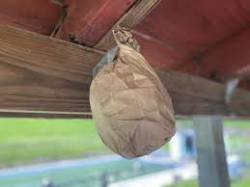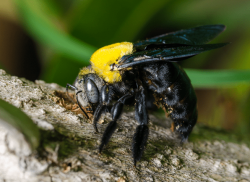Brown Bag DYI for Carpenter Bees

Brown bags are not typically used to stop carpenter bees. However, there is a common DIY method that involves using brown paper bags to deter carpenter bees from nesting in wooden structures. The idea behind this method is that the bees mistake the brown paper bags for the wooden structures they typically nest in and are therefore discouraged from nesting there.
To use this method, you can simply fill brown paper bags with crumpled newspaper or other filler material and hang them near the wooden structures you want to protect. The bags should be hung in a way that they move with the wind, as this can help make them appear more convincing to the bees.
It’s important to note that this method may not be effective for all carpenter bee infestations and may need to be combined with other methods for full control. Additionally, it’s important to properly identify the type of bee you’re dealing with, as there are many other types of bees and wasps that can also be harmful to wooden structures. If you’re unsure about how to handle a carpenter bee infestation, it’s best to consult with a pest control professional.
Carpenter Bee Facts

- Carpenter bees are large, solitary bees that are found throughout the world.
- Unlike honeybees, carpenter bees do not live in colonies. Instead, they build individual nests in wood.
- Carpenter bees are important pollinators of many types of plants, including fruit trees and flowers.
- The female carpenter bee is the only one that can sting, but she is generally not aggressive and will only do so if provoked or threatened.
- Carpenter bees can cause damage to wooden structures over time, as they bore holes into the wood to create their nests.
- Carpenter bees are often mistaken for bumblebees due to their similar appearance, but they have a shiny, hairless abdomen instead of a fuzzy one.
- There are several species of carpenter bees found in North America, including the Eastern carpenter bee and the California carpenter bee.
- Carpenter bees have a long tongue that allows them to access nectar from deep flowers.
- Carpenter bees are active during the daytime and often hover near flowers and other sources of nectar.
- To prevent carpenter bee damage to wooden structures, it’s important to regularly inspect and maintain the wood, seal any cracks or crevices, and consider using repellents or other control methods as needed.
Pingback: Bees In March